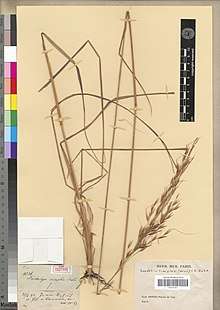Loudetia simplex
Loudetia simplex is a grass species found in tropical and Southern Africa and Madagascar.[3] It was originally described as a Tristachya species by Christian Gottfried Daniel Nees von Esenbeck in 1841[4]:269 and was transferred to Loudetia by Charles Edward Hubbard in 1934.[1]
| Loudetia simplex | |
|---|---|
 | |
| Type specimen at MNHN | |
| Scientific classification | |
| Kingdom: | Plantae |
| Clade: | Tracheophytes |
| Clade: | Angiosperms |
| Clade: | Monocots |
| Clade: | Commelinids |
| Order: | Poales |
| Family: | Poaceae |
| Subfamily: | Panicoideae |
| Genus: | Loudetia |
| Species: | L. simplex |
| Binomial name | |
| Loudetia simplex | |
| Synonyms | |
| |
The species is a perennial bunch grass, with culms erect and 30–150 cm (12–59 in) long. Leaves are mostly basal, with flat, convolute blades 10–30 cm (3.9–11.8 in) long and 2–5 mm wide. The inflorescence is a 10–30 cm (3.9–11.8 in) long panicle of spikelets, each containing one sterile and one fertile flower. The lemma carries a 25–50 mm long awn.[5]
Like all Loudetia species, L. simplex uses C4 photosynthesis and occurs in open habitats, often on poor shallow soils. It is a significant weed species.[6]
Two subspecies have been described:[1]
- Loudetia simplex subsp. simplex
- Loudetia simplex subsp. stipoides
In Madagascar, it is one of the dominant grassland species in the central high plateaus,[7] where it occurs on leached, poorly drained soils and is quite fire-resistant. In Malagasy, it is known locally as horona, horo, berambo, kilailay, kirodrotra, or felika. It has only medium value as pasture grass.[8]
References
- "Tropicos - Loudetia simplex (Nees) C.E.Hubb". Retrieved 4 March 2018.
- Hubbard, C.E. (1934). "Notes on African Grasses: XVII". Bulletin of Miscellaneous Information (Royal Gardens, Kew). 1934 (10): 425. doi:10.2307/4114347. ISSN 0366-4457. JSTOR 4114347.
- "World Checklist of Selected Plant Families - Loudetia simplex (Nees) C.E.Hubb". Retrieved 4 March 2018.
- Nees von Esenbeck, C.G.D. (1841). Florae Africae Australioris Illustrationes Monographicae (in Latin). OCLC 727189281.
- Clayton, W.D.; Vorontsova, M.S.; Harman, K.T.; Williamson, H. "Loudetia simplex". GrassBase - The Online World Grass Flora. Royal Botanic Gardens, Kew. Retrieved 4 March 2018.
- Watson, L.; Macfarlane, T.D.; Dallwitz, M.J. "Grass genera of the world - Loudetia Hochst". Retrieved 4 March 2018.
- Moat, J.; Smith, P. (2007). Atlas of the vegetation of Madagascar. Richmond, Surrey: Royal Botanic Gardens, Kew. ISBN 9781842461983.
- Kull, C.A. (2003). "Fire and the management of highland vegetation". In Goodman, S.M.; Benstead, J.P. (eds.). The natural history of Madagascar. Chicago, London: The University of Chicago Press. pp. 153–157. ISBN 978-0226303079.